2.a glacial processes + land forms
0.0(0)
Card Sorting
1/110
There's no tags or description
Looks like no tags are added yet.
Study Analytics
Name | Mastery | Learn | Test | Matching | Spaced |
|---|
No study sessions yet.
111 Terms
1
New cards
freeze-thaw (physical weathering)
water enters rock cracks -\> expands when refreezes -\> exerts pressure on rock -\> rock splits/breaks off
2
New cards
frost shattering (weathering)
water trapped in rock pores -\> freezes -\> expands -\> repeating freezing and thawing -\> rock joints weaken and widen -\> rock breaks into small particles away from main body of rock
3
New cards
oxidation
oxygen combines with another substance to create oxides which breaks rocks apart
4
New cards
oxidation - rock
sandstone (iron rich material)
5
New cards
carbonation
water mixes with CO2 to make carbonic acid which reacts with rocks making them easily crumble
6
New cards
carbonation - rock
limestone or chalk
7
New cards
solution
minerals soluble in water, dissolve, wreaking structure of rock
8
New cards
solution - rock
limestone
9
New cards
hydrolysis
chemical reaction between rock minerals and acidic water to create other materials
10
New cards
hydrolysis - rock
granite -\> clay
11
New cards
hydration
water reacts with minerals, rock absorbs water making it suffer
12
New cards
hydration - rock
anhydride -\> gypsum
13
New cards
factors influencing rates of weathering
- rock type
- climate
- vegetation
- climate change
- aspect
- location
- altitude
- climate
- vegetation
- climate change
- aspect
- location
- altitude
14
New cards
mass movement examples
-rock fall
-sliding
-slumping
-sliding
-slumping
15
New cards
rock fall
rocks become detached by physical weathering processes and fall to create scree slopes
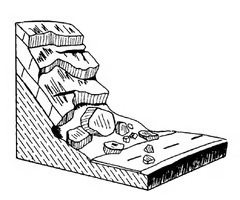
16
New cards
sliding
movement downhill (blocks of rock) along a straight-line slip plane
17
New cards
slumping
slides may occur due to steepening under-cutting of valley sides by erosion at the base of the slope

18
New cards
plucking (erosion)
meltwater in joints of rocks -\> freezes -\> attach to glacier -\> glacier advance -\> pluck rock
19
New cards
abrasion (erosion)
debris embedded in base/side of glacier -\> rock moves in ice under force of gravity -\> scrapes/indents valley floor/sides in glacier as it moves
20
New cards
example of a corrie
The Walcott Corrie, Antartica, 3km high back wall
21
New cards
example of an arete
Striding Edge, Lake District, 200-300km high
22
New cards
example of a pyramidal peak
Matterhorn, Swiss Alps, over 1200m high
23
New cards
example of a roche moutonnee
Norfolk Island, Lake District
24
New cards
example of a glacial trough
Glen ridding Valley, Lake District
25
New cards
example of a ribbon lake
Ullswater, Lake District
26
New cards
example of a hanging valley
Helvellyn Gill, Lake District
27
New cards
example of a truncated spur
Walls Crag, Lake District
28
New cards
lodgement till
material deposited by moving ice when its weight becomes too heavy to move
29
New cards
ablation till
material which is deposited directly at the end of the glacier by water melting when the ice is stagnant
30
New cards
moraines
deposits of glacial till
31
New cards
ground moraine
unsorted material left all over ground as glacier retreats up valley in warmer times (lodgement till)
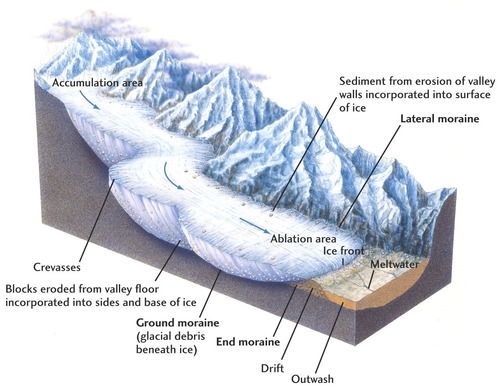
32
New cards
terminal moraine
rocks deposited (ablation till) in a ridge at max advance of ice
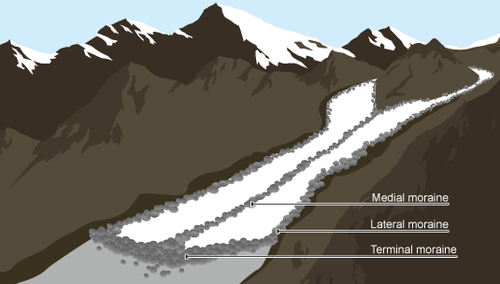
33
New cards
lateral moraine
ridges from valley sides and run parallel to them
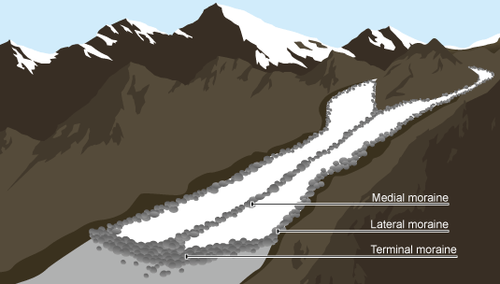
34
New cards
medial moraine
ridge of rocks running down the middle of a valley formed by 2 lateral moraines from 2 glaciers coming together
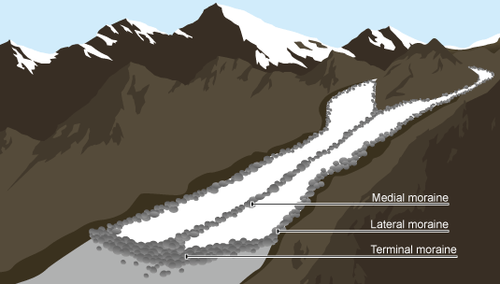
35
New cards
recessional moraine
ridges parallel to terminal moraines marking the retreat of a glacier (ablation till) - the less time the glacier was stagnant the less material there will be
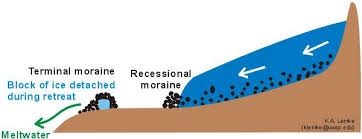
36
New cards
push moraine
mounds of material found where a drop in temp or increase in precipitation allows glacial re-advance and the glacier pushes previously deposited moraines forward
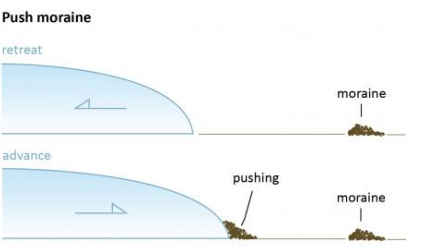
37
New cards
till plains
large expanse of gently rolling hills of till - forms when a large mass of unstratified drift is deposited at the end of an ice sheet when it detaches from the main body of a claire and melts
38
New cards
erratics
large rocks or boulder that have been picked up (plucked) by a glacier or ice sheet, transported and deposited in a new area
39
New cards
drumlins
half-egg shaped hills of till
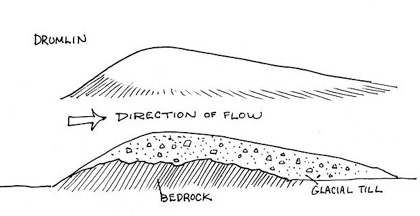
40
New cards
example of an erratic
Norber erratics, Yorkshire Dales
41
New cards
example of a drumlin
Vale of Eden, Lake District
42
New cards
transportation
- rockfall
- avalanches
- debris flow
- aeolian deposits
- volcanic eruptions
- plucking
- abrasion
- avalanches
- debris flow
- aeolian deposits
- volcanic eruptions
- plucking
- abrasion
43
New cards
subglacial debris
embedded in the base of the glacier
44
New cards
supraglacial debris
carried on the surface of a glacier
45
New cards
englacial debris
debris within the ice
46
New cards
erosional landforms
-corries
-arêtes
-pyramidal peaks
-troughs
-roche moutonnee
-striations
-arêtes
-pyramidal peaks
-troughs
-roche moutonnee
-striations
47
New cards
depositional landforms
-terminal moraine
-lateral moraine
-recessional moraine
-erratic
-drumlin
-till plain
-lateral moraine
-recessional moraine
-erratic
-drumlin
-till plain
48
New cards
folding
the bending of rock layers due to stress
49
New cards
faulting
process of cracking that occurs when the folded land cannot be bent any further
50
New cards
geomorphic processes
-erosion
-weathering (physical, biological and chemical weathering)
-mass movement
-transportation
-deposition
-weathering (physical, biological and chemical weathering)
-mass movement
-transportation
-deposition
51
New cards
conditions for physical weathering
high altitude/low latitude for variation in temperatures to allow for melting and freezing
52
New cards
pressure release (physical weathering)
weight of overlying ice in a glacier is lost due to melting -\> underlying rock expands -\> rock fractures parallel to the surface -\> significant exposure of sub-surface rocks -\> these rocks are more susceptible to other forms of weathering e.g. freeze thaw
53
New cards
where in a glacial system will pressure release most likely occur
areas where ice has retreated
54
New cards
biological weathering
weathering of rocks caused by tree roots or the decomposition of plant and animal matter
55
New cards
chelation
the organic acid produced by decomposition that reacts with rocks
56
New cards
significance of biological weathering
not significant in glacial regions - more in tundra/periglacial regions and only in summer
57
New cards
chemical weathering makes rocks more prone to...
erosion later on
58
New cards
conditions for chemical weathering
high altitude/low latitude - variations in temperature as it needs water present to react with rocks
59
New cards
rotational movement (erosion)
occurs in a corrie -\> downhill movement of ice pivoting around a point and overdeepening at that point -\> enables abrasion and plucking to take place
60
New cards
solifluction (weathering)
base of the glacier where ice melt through friction occurs -\> eroded material is carried along under the glacier -\> debris is accumulated in glacier and alter deposited
61
New cards
rock conditions for effective plucking
when the rock is jointed or previously weathered and requires the presence of meltwater
62
New cards
abrasion requires...
meltwater for movement to occur and so is less effective in cold-based glaciers
63
New cards
difference between abrasion and plucking
abrasion is scratching while plucking is the removal of chunks of rock
abrasion in glaciers require rocks to erode the valley while plucking is the use of meltwater to carry rock fragments
abrasion in glaciers require rocks to erode the valley while plucking is the use of meltwater to carry rock fragments
64
New cards
3 factors influencing the rate of abrasion
amount of basal debris, speed of ice movement (steepness and meltwater), debris size and volume
65
New cards
how does steepness influence the rate of abrasion
increased steepness -\> increased speed of ice movement -\> friction is greater
66
New cards
the more basal debris in a glacier, the rate of abrasion will be...
...higher
67
New cards
the rate of abrasion by cold based glacier is...
...low as no meltwater means little movement
68
New cards
how does debris size and shape influence the rate of abrasion
larger and sharper rocks will abrade more
69
New cards
basal water pressure
in warm based glaciers there is presence of meltwater underneath and the pressure is increased by the height of the glacier and so the basal pressure will move the water quicker
70
New cards
nivation occurs...
...when snow starts to accumulate
71
New cards
nivation
weathering such as freeze thaw and erosion such as abrasion combined
72
New cards
nivation over time leads to...
...nivation hollows
73
New cards
nivation hollows
shallow pits as a result of nivation
74
New cards
how nivation hollows develop into corries
pits trap more snow -\> more compression of snow -\> increase pressure -\> compacted snow and ice -\> deepen further to form a corrie
75
New cards
how rock type influences rate of weathering
rock with a weak structure is more prone to physical weathering
chemical weathering can only occur in certain types of rocks
chemical weathering can only occur in certain types of rocks
76
New cards
types of chemical weathering
oxidation, carbonation, solution, hydrolysis and hydration
77
New cards
how climate influences rate of weathering
glaciated regions -\> colder, slightly drier locations will be more prone to physical weathering
non glaciated regions -\> warmer, slightly wetter locations will be more prone to chemical weathering
non glaciated regions -\> warmer, slightly wetter locations will be more prone to chemical weathering
78
New cards
how vegetation influences rate of weathering
more vegetation (in non glaciated regions) -\> enhances biological weathering
79
New cards
how climate change influences rate of weathering
increase burning of fossil fuels -\> more CO2 -\> more carbonation
warmer temperatures -\> more melting -\> more chemical weathering
warmer temperatures -\> more vegetation -\> more biological weathering
warmer temperatures -\> more melting -\> more chemical weathering
warmer temperatures -\> more vegetation -\> more biological weathering
80
New cards
how aspect influences rate of weathering
face away from sun -\> colder -\> more physical weathering
face toward the sun -\> fluctuating temperatures around 0C -\> more freeze-thaw weathering
face toward the sun -\> fluctuating temperatures around 0C -\> more freeze-thaw weathering
81
New cards
how location influences rate of weathering
high latitudes -\> less chemical weathering / some physical weathering / weathering will be slower
high altitudes, low latitudes -\> more chemical weathering or freeze-thaw weathering will dominate
location determines the amount of precipitation
high altitudes, low latitudes -\> more chemical weathering or freeze-thaw weathering will dominate
location determines the amount of precipitation
82
New cards
how altitude influences rate of weathering
higher the altitude -\> colder it will be -\> less chemical weathering
higher temperatures -\> more chemical weathering
higher temperatures -\> more chemical weathering
83
New cards
corrie characteristics
-armchair shaped hollow
-steep back wall
-over deepened basin with a lip at the front
-steep back wall
-over deepened basin with a lip at the front
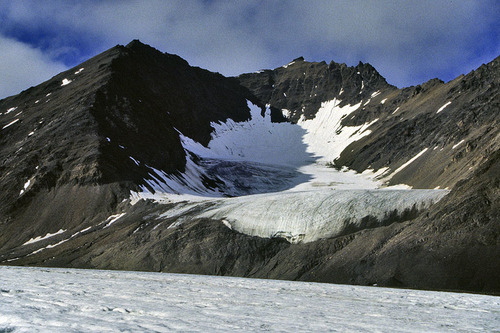
84
New cards
corrie formation
1. snow (input) falls and accumulates and nivation deepens the hollow it collects in
2. over time the hollow enlarges and contains more snow which is eventually compressed into glacier ice
3. the ice acquires a rotational movement under its own weight which enlarges the hollow further - meanwhile the rotational movement causes plucking of the back wall, making it increasingly steep
4. the debris derived from plucking and weathering above the hollow falls into the Bergschrund crevasse which steepens the back wall and abrades the hollow deepening it
5. once the hollow has deepened, the thinner ice at the front is unable to erode so rapidly and so a higher lip is left
6. post-glacial landscape the corrie may become filled with water forming a small lake or tarn

85
New cards
role of energy in corrie formation?
* gravitational potential energy → rotational movement
* kinetic energy → less of it so forms a higher lip as hollow deepens
* heat/solar energy → small circular lake or tarn
* kinetic energy → less of it so forms a higher lip as hollow deepens
* heat/solar energy → small circular lake or tarn
86
New cards
arête characteristics
-narrow, steep-sided ridge found between two corries
-knife-edged
-knife-edged
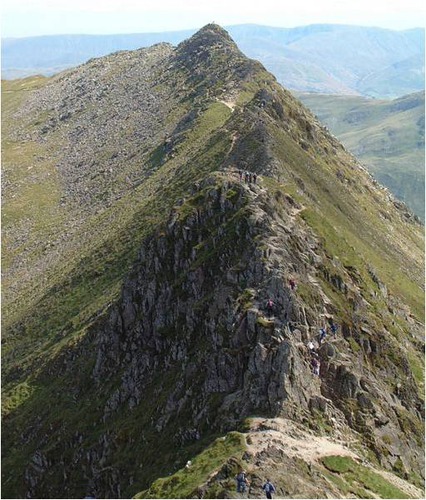
87
New cards
arête formation
1. corrie formation
2. 2 corries form side by side and erode backwards into the mountain, narrowing the peak
2. 2 corries form side by side and erode backwards into the mountain, narrowing the peak
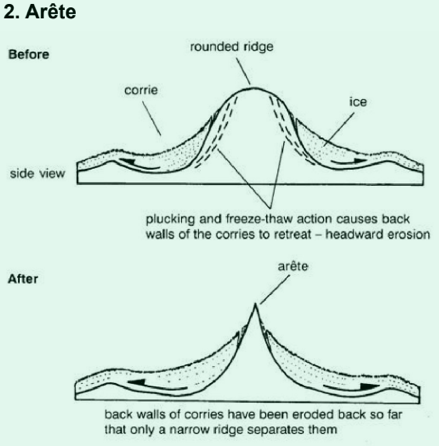
88
New cards
role of geomorphic processes in the formation of aretes
corrie
* weathering
* erosion: plucking and abrasion
* deposition
arête
* erosion: two corries retreat + slopes steepen to form a sharp ridge
* weathering
* erosion: plucking and abrasion
* deposition
arête
* erosion: two corries retreat + slopes steepen to form a sharp ridge
89
New cards
pyramidal peak characteristics
-sharp-edged mountain peak
90
New cards
pyramidal peak formation
1. three or more arêtes/corries form back to back around a mountain top and their back walls retreat to create a peak
2. nivation and weathering of the peak may further sharpen its shape
2. nivation and weathering of the peak may further sharpen its shape
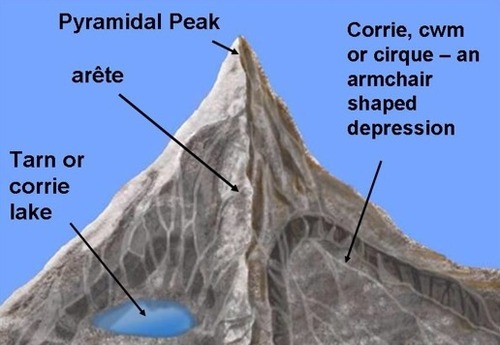
91
New cards
roche moutonnee characteristics
-smooth
-streamlined by abrasions
-straitions
-rock hill shaped
-streamlined by abrasions
-straitions
-rock hill shaped

92
New cards
roche moutonnee formation
1. resistant rock found on valley floor which advancing ice passes over
2. localised pressure melting occurs and abrasion on the up-valley side (stoss) -\> smooth rock with striations
3. on the down-valley side (lee) pressure is reduced and meltwater re-freezes, resulting in plucking and the steeping of the rock
2. localised pressure melting occurs and abrasion on the up-valley side (stoss) -\> smooth rock with striations
3. on the down-valley side (lee) pressure is reduced and meltwater re-freezes, resulting in plucking and the steeping of the rock
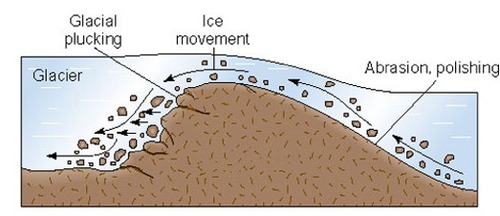
93
New cards
glacial trough formation
1. glaciers flow down pre-existing V-shaped river valleys under gravity - the mass of the ice has far more erosive power than a river and so erodes the sides and floor of the valley
2. as it moves (gravitational potential energy) it plucks the rock from beneath and those rocks rub against (abrasion) the bed of valley, eroding it further making the shape become deeper, wider and straighter
its long profile is a realist of compressing flows making the valley over-deepened to form rock basins and rocks steps, particularly evident where there are alternating bands of rock of different resistances on the valley floor (the weaker rocks being eroded more rapidly to form the basins)
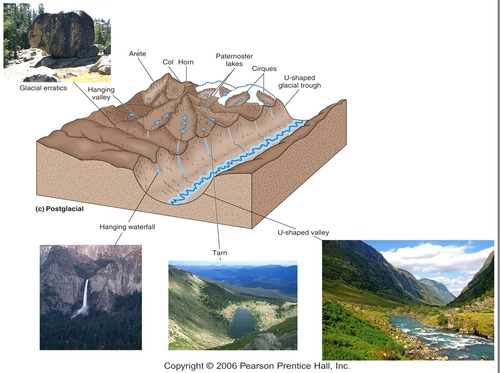
94
New cards
glacial trough characteristics
-U-shaped valley
-deep
-wide
-straight
-deep
-wide
-straight
95
New cards
hanging valley formation
smaller/tributary valleys feed into the main valley as they have been eroded slower and shallower - sit between truncated spurs
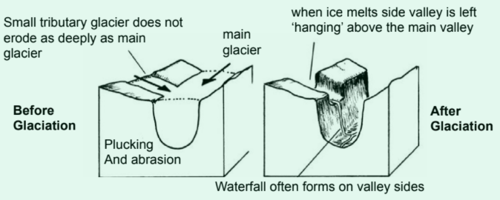
96
New cards
truncated spur characteristics
-steep-sided
-wide
-relatively flat-bottomed
-wide
-relatively flat-bottomed
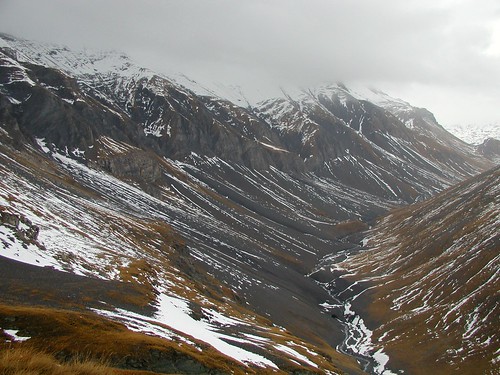
97
New cards
truncated spur formation
1. a river flows through the landscape, creating interlocking spurs.
2. interlocking spurs are truncated as the glacier cuts straight through the landscape by the processes of abrasion, plucking freeze-thaw.
3. the truncated spurs can then be identified by the exposed rock found on valley sides. They will continue to steepen after glaciation due to freeze-thaw
2. interlocking spurs are truncated as the glacier cuts straight through the landscape by the processes of abrasion, plucking freeze-thaw.
3. the truncated spurs can then be identified by the exposed rock found on valley sides. They will continue to steepen after glaciation due to freeze-thaw
98
New cards
ribbon lake characteristics
- long, narrow lake
- found in the bottom of a glacial trough
- found in the bottom of a glacial trough
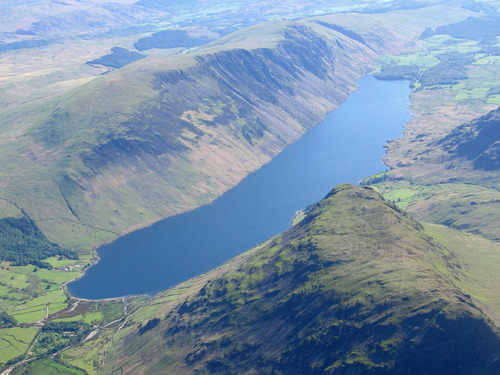
99
New cards
ribbon lake formation
1. extending and compressing flows causes the valley floor to over deepen at a variety of erosional rates due to thicker ice or areas of softer rock
2. this means that some parts of the valley floor are over deepened creating ribbon lakes
2. this means that some parts of the valley floor are over deepened creating ribbon lakes
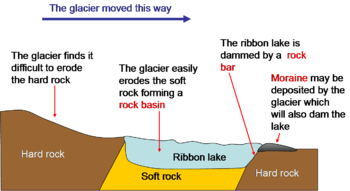
100
New cards
striations formation
scratches or grooves made by debris embedded in the base of the glacier - abrasion is the key process